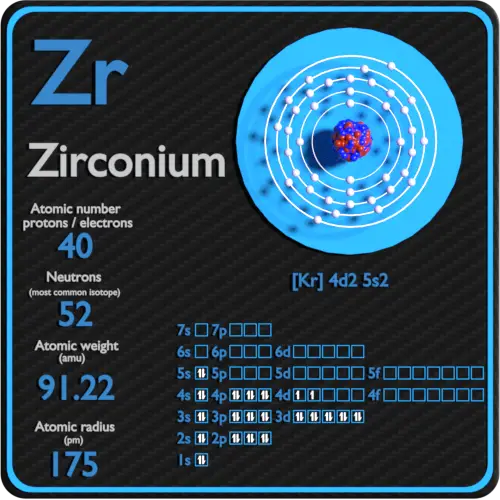

All possible symmetric arrangements of particles in three-dimensional space are described by the 230 space groups (219 distinct types, or 230 if chiral copies are considered distinct. The symmetry properties of the crystal are described by the concept of space groups. The positions of the atoms inside the unit cell are described by the set of atomic positions ( x i, y i, z i) measured from a reference lattice point. The unit cell is represented in terms of its lattice parameters, which are the lengths of the cell edges Lattice Constants (a, b and c) aĪnd the angles between them Lattice Angles (alpha, beta and gamma). The unit Cells repeats itself in three dimensional space to form the structure. The Crystal structure can be described in terms of its unit Cell.

© IUPAC (International Union of Pure and Applied Chemistry).The solid state structure of Zirconium is Simple Hexagonal. Source: Adapted from Pure and Applied Chemistry 78, no. R Range in isotopic composition of normal terrestrial material prevents a more precise Ar(E) being given the tabulated Ar(E) value and uncertainty should be applicable to normal material. Substantial deviations in the atomic mass of the element from that given in the table can occur. M Modified isotopic compositions may be found in commercially available material because it has been subjected to an undisclosed or inadvertent isotopic fractionation. The difference between the atomic mass of the element in such specimens and that given in the table may exceed the stated uncertainty. G Geological specimens are known in which the element has an isotopic composition outside the limits for normal material. †Commercially available Li materials have atomic weights that range between 6.939 and 6.996 if a more accurate value is required, it must be determined for the specific material. However, three such elements (Th, Pa, and U) have a characteristic terrestrial isotopic composition, and for these an atomic mass is tabulated. Table A.1 The Basics of the Elements of the Periodic Table Name For example, see PTable and the Accessible Syngenta Periodic Table of Elements. The mineral was not known to contain a new element until Klaproth, in 1789, analyzed a jargon from Ceylon and identified the new element, which Werner named zircon (silex circonius. This mineral, or its variations, is mentioned in biblical writings. The web offers many interactive periodic table resources. Zircon, the primary gemstone of zirconium, is also known as jargon, hyacinth, jacinth, or ligure. Some elements, such as lithium, can have varying atomic masses depending on how their isotopes are isolated. The atomic masses of other elements, especially radioactive elements, are not known as precisely. The atomic masses of some elements are known very precisely, to a large number of decimal places. The atomic masses in Table A.1 “The Basics of the Elements of the Periodic Table” represent the number of decimal places recognized by the International Union of Pure and Applied Chemistry, the worldwide body that develops standards for chemistry. However, some applications (especially nuclear chemistry see Chapter 15 “Nuclear Chemistry”) require more decimal places. For many applications, only one or two decimal places are necessary for the atomic mass.

One item on most periodic tables is the atomic mass of each element.

What follows here is a more complex version of the periodic table than what was presented in the chapter “Atoms, Molecules, and Ions.” The internet is a great place to find periodic tables that contain additional information. Periodic tables are available with a variety of chemical and physical properties listed in each element’s box. Many of the physical and chemical properties of the elements are either known or understood based on their positions on the periodic table. The periodic table is arguably the best tool in all of science no other branch of science can summarize its fundamental constituents in such a concise and useful way. The periodic table, introduced in Chapter 3 “Atoms, Molecules, and Ions,” lists all the known chemical elements, arranged by atomic number (that is, the number of protons in the nucleus). Because zirconium is an element, it cant be broken down. In this appendix, we present some data on the chemical elements. On the periodic table of the elements, Zirconium is element number 40 and its symbol is Zr. Appendix A: Periodic Table of the Elements


 0 kommentar(er)
0 kommentar(er)
